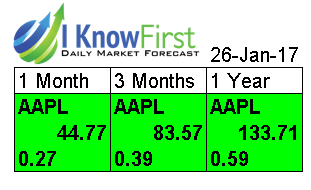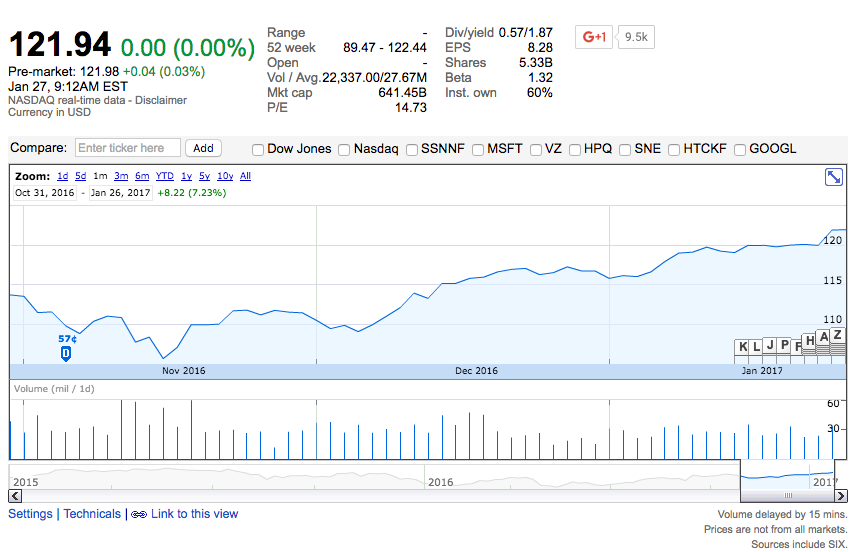![]() The article was written by Motek Moyen Research Seeking Alpha’s #1 Writer on Long Ideas and #2 in Technology – Senior Analyst at I Know First.
The article was written by Motek Moyen Research Seeking Alpha’s #1 Writer on Long Ideas and #2 in Technology – Senior Analyst at I Know First.
Apple Stock Forecast
Summary:
- The world spent $44.8 billion on mobile apps last year. This industry helped Apple improve its Services revenue by 24% during the most recent quarter.
- Apple does around 70% of the global apps business.
- Apple takes 30% commission from app store and in-app purchases done through iOS devices.
- Strong revenue stream from iTunes App Store could inspire Apple to reduce prices of its iPhone and iPad products in China and other developing markets.
- I Know First gives AAPL very positive buy signals based on its near and long-term algorithmic forecasts.
Apple (AAPL) device owners helped spent $44.8 billion on mobile apps last year. As a vendor of high-end phones and pricey tablets, Apple’s client base is full of well-to-do people with extra spending power. Expect the people who can afford $700 iPhones to spend $50-$300 every year on iOS apps.
The revenue from Apple’s 30% cut over iOS app store purchases is tremendous. Hit mobile games like Pokemon Go (released only last July) generated $950 million in revenue in 2016. The 9-figure annual commission on in-app purchases can help Apple offset its declining Mac and iPad business segments. Services, where the iTunes App Store belongs to, grew 24% in Q4 with $6.3 billion in revenue.
Source: Newzoo
Apple device owners spent $240 million in January 1, 2017 on iTunes App Store, setting a record. The addictive nature of hit mobile games like Game of War: Fire Age, Clash Royale, and Candy rush Saga means iPhone/iPad owners will remain repeat in-app buyers for many years to come.
In America alone, iPhone gamers are spending approximately $7.78 million everyday on the top-10 grossing iOS games. Apple therefore gets $2.33 million everyday of almost-cost free, easy money from American iPhone gamers.
(Source: ThinkGaming)
Mobile Apps Industry Is Still Growing
Based on the projection of Superdata Research, the business of mobile apps is also predicted to grow to $54.5 billion by 2019. Apple therefore can rely on this particular industry to fuel growth for its Services segment for the next three years.
(Source: Superdata)
On this note, Apple has to improve its iTunes App Store platform to encourage more iPhone/iPad owners to do in-app purchases or app store subscriptions. I suggest Apple allows iPhone owners with cellular service subscriptions to do app store purchases through carrier billing, not just through credit card payments.
There are iPhone/iPad owners in China, India, and Africa that cannot qualify for credit card applications. They do qualify for carrier subscriptions.
App Store Revenue Could Help Reduce Prices of iPhones, Macs, and iPad Tablets
There are fewer Apple mobile device than Android device users. However, according to App Annie, the iOS app store did 70% of the estimated $44.8 billion spent on app/games last year. It helps that Apple has an official app store in China, while Google (GOOG) has none. China is now the biggest market for mobile apps, worth $10 billion last year.
If we guesstimate that China’s 50% of China’s mobile apps industry went through the iTunes App Store there, Apple could be deriving $1.5 billion in annual commission. Getting $1.5 billion every year from Chinese in-app purchases could help Apple reduce the retail prices of its phones and tablets there.
Apple’s declining iPhone business in China is likely due to rising competition from much more affordable high-end Android phones made by Xiaomi, Huawei, Lenovo, and Vivo. The strong revenue steam from global iTunes App Store could subsidize a global-wide price reduction of iPhone and iPad products to help them compete better.
Conclusion
Apple’s stock went down by more than 2.5% after it did its earnings report today. It might go lower when market opens on Friday. Investors should try for a cheap buy-in window to purchase AAPL. I rate this stock as a strong buy for the long-term horizon.
On the other hand, I Know First’s short and long-term algorithmic forecasts for AAPL are all positive. The stock could shoot up to $125 within the next 30 days or 90 days.
 I Know First Algorithm Heatmap Explanation
I Know First Algorithm Heatmap Explanation
The sign of the signal tells in which direction the asset price is expected to go (positive = to go up = Long, negative = to drop = Short position), the signal strength is related to the magnitude of the expected return and is used for ranking purposes of the investment opportunities.
Predictability is the actual fitness function being optimized every day, and can be simplified explained as the correlation based quality measure of the signal. This is a unique indicator of the I Know First algorithm. This allows users to separate and focus on the most predictable assets according to the algorithm. Ranging between -1 and 1, one should focus on predictability levels significantly above 0 in order to fill confident about/trust the signal.
There are 26 TipRanks-tracked Wall Street analysts that also rate AAPL as a strong buy. Their average consensus 12-month price target for AAPL is $136.61.
(Source: TipRanks)
I Know First Pass Success With AAPL
I Know First has been bullish on AAPL shares in past forecasts. On October 31st, 2016, an I Know First analyst wrote a bullish article on Apple Inc. in accordance with I Know First’s self-learning algorithm. The analyst wrote about a growth in iPhone sales during the 2016 holiday sales. In accordance with the algorithmic forecast, AAPL shares rose 7.23% to date.
The bullish forecast on AAPL was sent to I Know First subscribers on October 30th, 2016. To Subscribe today click here.






